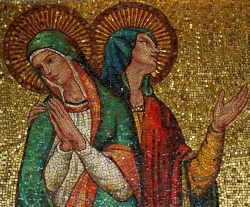
Next on our list are Sts. Perpetua and Felicity. Even if their names are not easily recognizeable, they are among the most well-known and widely studied martyrs of the 3rd century. Many martyrdom account manuscripts have been lost to time, decay, or barbarian hordes, but we have received The Passion of St. Perpetua, St. Felicity, and their Companions as a complete text! It preserves the account of the arrest and imprisonment of the saints as given by eyewitnesses and the saints’ own testimony.
Vibia Perpetua was a 22-year-old married noblewoman and nursing mother, and Felicity was her servant, friend, and expectant mother. Perpetua had made her decision to be baptized in 203 AD under the rule of Emperor Septimius Severus, even though she knew that it could mean her death. Her father and family members pleaded with her to recant, but she replied that she couldn’t and said, “Neither can I call myself by any other name than what I am – a Christian.”
Perpetua and Felicity were imprisoned and awaited execution in the arena in their hometown of Carthage in North Africa. The conditions were terrible, but the Church sent deacons to minister to them and other Christians, even bribing the guards to provide better living conditions. The two women and their companions (Saturus, Revocadus, Rusticus, and Saturninus) continued to be people of prayer, even as they awaited their death, and their example resulted in the conversion of the jail warden, a man named Pudens.
The actual martyrdom account interestingly mirrors many of the aspects of Jesus’ own Passion. Perpetua, Felicity, and their companions were led into the center of the arena to await judgment of the crowds (like Jesus). Beautifully, the servant and master had become sisters and friends in their suffering for Christ. The crowd demanded that they be scourged first (like Jesus), and they were stripped naked for humiliation (like Jesus). The group of martyrs was then attacked by leopards, wild boars, and bears (oh my!), and Perpetua and Felicity were chained to the side of a crazed bull, which beat and trampled them severely. When the brutal attacks by the beasts had concluded, soldiers were dispatched to ensure that the martyrs were dead (like Jesus). When one of them, a young novice, approached Perpetua, he was so moved by her loving suffering that he couldn’t bring himself to dispatch her. Perpetua, fully aware of the consequences for the soldier disobeying his order, and willing to lay her own life down (like Jesus), steadied his hand and guided the sword into her body.
We have so much that we can take away from this passion account, including evidence for many closely held teachings of the Church, including baptism by desire (Perpetua’s brother died as a catechumen, but she dreamed he was saved) and prayers for the souls in Purgatory (her other brother Dinocrates, who had died with a disfiguring illness, appeared to her in a vision and was healed after she prayed for his soul). There is also a scene where the martyr Saturus gives his family ring to Pudens the warden in gratitude; Pudens later dips the ring in Saturus’ blood and keeps it to venerate the martyrs’ death, which seems to be clear evidence of the use of relics!
Perhaps the greatest lesson we learn follows the last recorded words of St. Perpetua: “Stand fast in faith, and love one another.” Sts. Perpetua, Felicity, and their Companions, pray for us!